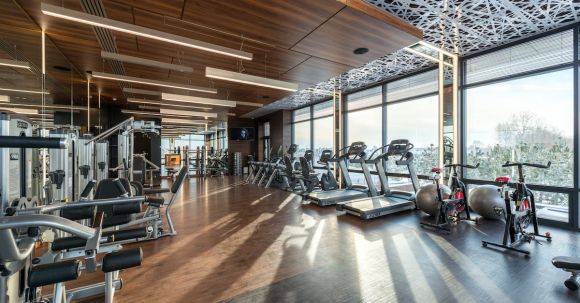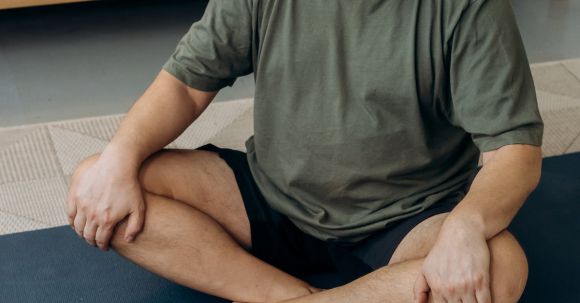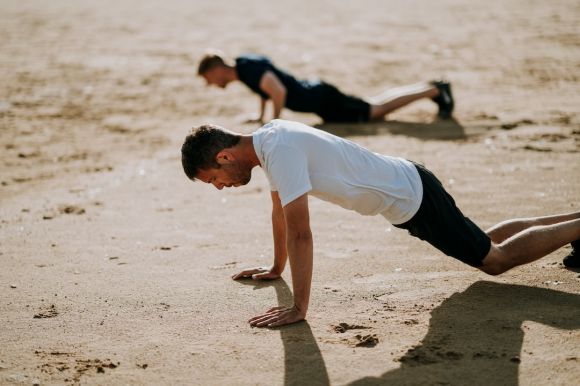Cardiovascular exercises, also known as cardio exercises, are a great way to improve lung capacity and enhance respiratory health. These exercises increase the demand for oxygen, forcing your heart and lungs to work harder. Over time, this can lead to better lung function and improved overall respiratory fitness. In this article, we will explore some effective cardio exercises that can help you achieve these goals.
Author: fit-on
Introduction:
Osteoporosis is a condition characterized by weak and brittle bones, making individuals more susceptible to fractures and breaks. It is a common problem, especially among older adults, and can significantly impact one's quality of life. However, there are effective ways to prevent and manage osteoporosis, and one such approach is through regular cardiovascular exercise. In this article, we will explore the benefits of cardio exercises for improving bone density and preventing osteoporosis.
The Importance of Bone Density:
Bone density refers to the strength and thickness of our bones. Higher bone density means stronger bones, which are less likely to break or fracture. Unfortunately, as we age, our bone density naturally decreases, increasing the risk of developing osteoporosis. However, engaging in regular cardio exercises can help combat this decline and even improve bone density over time.
Cardiovascular Exercise and Bone Health:
Cardio exercises, also known as aerobic exercises, are activities that increase heart rate and breathing rate. They are known for their numerous benefits, such as improving cardiovascular health, promoting weight loss, and reducing the risk of chronic diseases. However, many people are unaware of the positive impact cardio exercises can have on bone health.
1. Impact on Bone Density:
Engaging in weight-bearing cardio exercises, such as walking, jogging, dancing, or stair climbing, can help improve bone density. These activities put stress on your bones, which stimulates them to become stronger and denser. Regular cardio exercises can lead to increased bone mineral density, reducing the risk of fractures and osteoporosis.
2. Enhanced Muscle Strength:
Cardio exercises not only strengthen bones but also improve muscle strength. Strong muscles provide support to your bones, reducing the risk of falls and fractures. Additionally, cardio workouts help improve balance and coordination, further decreasing the chances of accidental injuries.
3. Hormonal Benefits:
Cardio exercises have been found to positively affect hormones that play a crucial role in bone health. For instance, engaging in regular cardiovascular activities stimulates the production of growth hormone, which aids in bone formation. Furthermore, cardio exercises can help regulate estrogen levels in women, preventing the rapid bone loss that occurs during menopause.
Incorporating Cardio Exercises Into Your Routine:
Now that we understand the benefits of cardio exercises for bone health, it's essential to know how to incorporate them into our daily routine.
1. Start Slowly:
If you're new to cardio exercises, it's important to start slowly and gradually increase the intensity and duration of your workouts. Begin with low-impact activities, such as walking or swimming, and then progress to more vigorous exercises over time.
2. Consistency is Key:
To reap the benefits of cardio exercises, consistency is crucial. Aim for at least 150 minutes of moderate-intensity cardio exercise per week or 75 minutes of vigorous-intensity exercise. It's best to spread these workouts throughout the week to ensure adequate recovery time for your muscles and bones.
3. Mix it Up:
Variety is key to staying motivated and preventing boredom. Incorporate a mix of different cardio exercises into your routine, such as cycling, dancing, or using an elliptical machine. This will not only keep your workouts interesting but also engage different muscle groups and stimulate bone growth from various angles.
Conclusion:
Regular cardiovascular exercise is a powerful tool in improving bone density and preventing osteoporosis. By engaging in weight-bearing activities, enhancing muscle strength, and benefiting from hormonal changes, you can significantly reduce your risk of fractures and maintain optimal bone health. Remember to start slowly, be consistent, and mix up your workouts to maximize the benefits. So, lace up your sneakers and start incorporating cardio exercises into your daily routine for stronger, healthier bones.
In today's fast-paced world, finding time to hit the gym or go for a run can be a challenge. However, maintaining cardiovascular fitness is crucial for overall health and well-being. The good news is that you don't need a gym membership or fancy equipment to get your heart pumping. With a little creativity and determination, you can amp up your cardiovascular fitness right in the comfort of your own home.
1. Jump Rope for Cardio
Jumping rope is a simple yet effective way to get your heart rate up and improve your cardiovascular fitness. It requires minimal space and equipment, making it perfect for home workouts. Start by setting a timer for 10 minutes and jump rope continuously, focusing on maintaining a steady rhythm. As you get more comfortable, increase the duration to challenge yourself further.2. High-Intensity Interval Training (HIIT)
HIIT workouts are a fantastic way to boost your cardiovascular fitness in a short amount of time. These workouts involve alternating between periods of high-intensity exercise and short recovery periods. You can incorporate exercises like burpees, mountain climbers, and high knees to get your heart rate soaring. Aim for at least 20 minutes of HIIT three times a week to see noticeable improvements in your cardiovascular endurance.3. Dance Your Way to Fitness
Dancing is a fun and enjoyable way to improve your cardiovascular fitness. Whether you follow along with dance workout videos or freestyle to your favorite tunes, dancing gets your heart pumping and your body moving. Not only does it burn calories, but it also releases endorphins, making you feel good both physically and mentally.4. Stair Climbing
If you have a set of stairs in your home, take advantage of them to get a great cardio workout. Climbing stairs is a low-impact exercise that engages multiple muscle groups and gets your heart rate up. Start by climbing up and down the stairs for a set amount of time, gradually increasing the duration as your fitness improves. To make it more challenging, try taking two steps at a time or adding weights for resistance.5. Circuit Training
Circuit training is a versatile workout that combines cardiovascular exercise with strength training. It involves performing a series of exercises back-to-back with minimal rest in between. You can create your own circuit using bodyweight exercises such as squats, lunges, push-ups, and plank. Aim for 10-15 repetitions of each exercise and complete the circuit for 3-4 rounds. Circuit training not only improves your cardiovascular fitness but also helps build strength and endurance.6. Indoor Cycling
Indoor cycling is a popular option for cardio workouts at home. If you have a stationary bike or a spin bike, you can easily replicate the experience of a cycling class in your living room. Set aside 30-60 minutes for your cycling session and focus on maintaining a steady pace. Increase the resistance as you get stronger to challenge yourself and improve your cardiovascular endurance. In conclusion, you don't need a gym membership or fancy equipment to amp up your cardiovascular fitness at home. By incorporating activities like jump rope, HIIT workouts, dancing, stair climbing, circuit training, and indoor cycling into your routine, you can improve your cardiovascular endurance and overall health. Remember to start at a comfortable level and gradually increase the intensity as your fitness improves. With dedication and consistency, you can achieve your fitness goals and enjoy the benefits of a healthy heart.
Are you feeling tired and lacking energy? Do you want to improve your overall fitness and feel more vibrant throughout the day? Look no further than cardio exercises! Cardiovascular exercises are not only great for improving your heart health, but they also have numerous benefits for increasing energy levels and overall fitness. In this article, we will explore some of the best cardio exercises that you can incorporate into your routine to boost your energy and enhance your fitness.
Jumpstart your day with a morning run
One of the most effective ways to increase your energy levels and kick-start your day is by going for a morning run. Running is a high-intensity cardio exercise that engages multiple muscle groups and gets your heart pumping. It releases endorphins, the feel-good hormones, which can leave you feeling energized and ready to take on the day. Whether you prefer a leisurely jog or a challenging sprint, a morning run is a fantastic way to boost your energy levels and improve your overall fitness.Dance your way to energy and fitness
Who says exercise has to be boring? Dancing is a fun and energetic cardio exercise that can provide a tremendous boost to your energy levels. Whether you join a dance class or simply dance around in your living room, moving to the rhythm of music can increase your heart rate and release endorphins. Not only will dancing improve your cardiovascular fitness, but it will also leave you feeling invigorated and full of energy.Cycling for an energy boost
If you're looking for a low-impact cardio exercise that can still deliver a high-energy workout, cycling is the perfect choice. Whether you prefer outdoor cycling or using a stationary bike, this exercise engages your leg muscles and gets your heart pumping. Cycling also helps to improve your stamina and endurance, allowing you to sustain higher energy levels throughout the day. It's a fantastic way to increase your fitness while reaping the benefits of a significant energy boost.Interval training for maximum energy
If you're short on time but still want to maximize your energy levels and overall fitness, interval training is the way to go. Interval training involves alternating between high-intensity exercises and short recovery periods. This type of workout not only increases your cardiovascular fitness but also enhances your body's ability to utilize oxygen, resulting in improved energy levels. Whether you're doing sprints, burpees, or jumping jacks, interval training is a highly efficient way to boost your energy and achieve your fitness goals.Swim your way to increased vitality
Swimming is a low-impact, full-body workout that can provide a multitude of benefits for your energy levels and overall fitness. The resistance of the water engages your muscles and increases your heart rate, resulting in improved cardiovascular fitness. Additionally, swimming is a great stress-reliever, and the rhythmic motion of swimming can help to relax your mind and leave you feeling refreshed and energized.Incorporate these cardio exercises into your routine
To increase your energy levels and improve your overall fitness, it's important to incorporate these cardio exercises into your routine regularly. Whether you choose to go for a morning run, dance your way to fitness, cycle for an energy boost, engage in interval training, or swim your way to increased vitality, each of these exercises can provide significant benefits for your energy levels and overall well-being. So, lace up your running shoes, turn up the music, hop on your bike, or dive into the pool – it's time to boost your energy and enhance your fitness with cardio exercises!
In today's fast-paced world, finding time for regular exercise can be a challenge. Traditional personal training often requires scheduling appointments and traveling to a gym or fitness center, which can be inconvenient and time-consuming. However, with the rise of online personal training, individuals now have the opportunity to work with a certified personal trainer from the comfort of their own homes. This article will explore the numerous benefits of online personal training and how it can help individuals achieve their fitness goals.
Flexibility and Convenience
One of the major advantages of online personal training is its flexibility and convenience. With traditional personal training, individuals are often bound by the availability of the trainer and the gym's operating hours. In contrast, online personal training allows individuals to exercise whenever and wherever it is convenient for them. Whether it's early morning or late at night, individuals have the freedom to fit their workouts into their busy schedules.Customized Training Programs
Online personal training offers the advantage of personalized training programs tailored to the individual's specific goals and needs. Through detailed questionnaires and assessments, certified trainers can create customized workout plans that address the individual's fitness level, preferences, and limitations. This personalized approach ensures that individuals receive targeted exercises that are both effective and safe.Access to Expertise
One of the most significant advantages of online personal training is the access to expertise. With traditional personal training, individuals are limited to trainers in their local area. However, with online personal training, individuals have access to a vast network of certified trainers from around the world. This means that individuals can choose trainers who specialize in their specific fitness goals, such as weight loss, strength training, or marathon training. The diverse expertise available online ensures that individuals receive the most up-to-date and effective training methods.Accountability and Motivation
Staying motivated and accountable can be challenging when working out alone. However, online personal training offers built-in accountability and motivation. Through regular check-ins, progress tracking, and communication channels with the trainer, individuals have someone to hold them accountable and provide ongoing support and encouragement. This added level of accountability and motivation increases the likelihood of individuals sticking to their workout routines and achieving their fitness goals.Affordability
Online personal training is often more affordable than traditional personal training. Without the overhead costs of a brick-and-mortar facility, online trainers can offer their services at a lower price point. This makes personal training accessible to a wider range of individuals who may have otherwise been unable to afford it. Furthermore, individuals can save on additional expenses such as gym memberships and travel costs, making online personal training a cost-effective option.Conclusion: A New Era of Fitness
Online personal training has revolutionized the fitness industry, providing individuals with a flexible, convenient, and personalized approach to achieving their fitness goals. With access to expertise from around the world, built-in accountability and motivation, and affordability, it's no wonder that more and more individuals are turning to online personal training to help them on their fitness journey. Whether you're a busy professional, a stay-at-home parent, or someone looking for a convenient way to exercise, online personal training offers numerous benefits that can help you reach your fitness goals. Embrace the new era of fitness and discover the advantages of online personal training today.
Are you tired of spending hours at the gym without seeing the results you desire? Do you want to build lean muscle and tone your body effectively and efficiently? Look no further than Fit on, the revolutionary fitness program that will transform your body and help you achieve your fitness goals.
Maximize Your Workouts with Fit on
Fit on is a comprehensive fitness program designed to help you build lean muscle and tone your body. With a combination of strength training exercises, high-intensity interval training (HIIT), and cardio workouts, Fit on provides a well-rounded approach to fitness that will help you achieve results faster.1. Strength Training
Strength training is a key component of building lean muscle. Fit on offers a variety of strength training exercises that target different muscle groups, allowing you to sculpt your body and increase your overall strength. Whether you prefer free weights, resistance bands, or bodyweight exercises, Fit on has a wide range of options to suit your needs.2. High-Intensity Interval Training (HIIT)
HIIT is a highly effective form of cardio that combines short bursts of intense exercise with periods of rest or lower intensity. Fit on incorporates HIIT workouts into its program, helping you burn calories and increase your cardiovascular fitness while also building lean muscle. These high-intensity workouts are quick and efficient, making them perfect for those with busy schedules.3. Cardio Workouts
Cardiovascular exercise is essential for overall health and fitness. Fit on offers a variety of cardio workouts, including running, cycling, and jumping rope, to help you improve your endurance and burn calories. These workouts can be done at home or at the gym, making them accessible to everyone.Customize Your Workouts with Fit on
One of the key features of Fit on is its ability to customize workouts based on your fitness level and goals. Whether you are a beginner or an experienced athlete, Fit on can tailor a workout plan that is specific to your needs. With a wide range of exercises and workout options, Fit on ensures that every workout is challenging and effective.Stay Motivated with Fit on
Staying motivated is crucial when it comes to achieving your fitness goals. Fit on provides a supportive community of like-minded individuals who are also on their fitness journey. With daily workout challenges, progress tracking, and motivational quotes, Fit on keeps you motivated and accountable, helping you stay on track and achieve the results you desire.Conclusion: Transform Your Body with Fit on
If you are ready to build lean muscle and tone your body, Fit on is the perfect fitness program for you. With its combination of strength training, HIIT workouts, and cardio exercises, Fit on offers a comprehensive approach to fitness that will help you achieve your goals faster. Customize your workouts, stay motivated, and transform your body with Fit on. Start your fitness journey today and see the results for yourself.
Whether you're a professional athlete or a weekend warrior, incorporating sports-specific workouts into your training routine can significantly enhance your performance on the field, court, or track. These targeted exercises are designed to improve the specific skills, strength, and endurance needed for your chosen sport. By tailoring your workouts to mimic the demands of your sport, you can take your game to the next level. Here are some tips on how to fine-tune your game with sports-specific workouts.
Basketball: Elevate Your Game
To excel in basketball, you need a combination of speed, agility, power, and stamina. Incorporate exercises that focus on these areas to enhance your performance on the court. Jumping rope can improve your footwork and coordination, while lateral lunges and lateral bounds can enhance your lateral quickness and agility. To boost your vertical leap, try plyometric exercises such as box jumps and depth jumps. Additionally, including exercises that target your core and upper body strength, like planks and push-ups, can improve your ability to drive to the hoop and defend against opponents.Soccer: Amp Up Your Endurance
Soccer requires a high level of cardiovascular endurance, as well as agility and lower body strength. Interval training, such as shuttle runs and sprints, can help improve your speed and stamina on the field. Incorporate exercises that mimic the movements of soccer, such as lateral shuffles and quick direction changes, to enhance your agility and quickness. Additionally, exercises like squats and lunges can strengthen your lower body, enabling you to sprint faster and kick with more power.Tennis: Improve Your Speed and Agility
Tennis demands quick movements, explosive power, and excellent footwork. To improve your speed and agility on the court, incorporate exercises such as ladder drills, cone drills, and agility ladder exercises into your training routine. These exercises can help improve your reaction time, lateral quickness, and change of direction. Additionally, including plyometric exercises like medicine ball throws and box jumps can enhance your explosive power, enabling you to deliver powerful shots and cover the court more efficiently.Swimming: Enhance Your Stroke Technique
Swimming requires a combination of upper body strength, core stability, and efficient stroke technique. To fine-tune your swimming performance, incorporate exercises that focus on these areas. Strengthen your upper body with exercises like pull-ups, push-ups, and dumbbell rows. Plank variations can help enhance your core stability, which is crucial for maintaining proper body alignment in the water. Additionally, practicing drills that target your stroke technique, such as single-arm drills or kickboard drills, can help improve your efficiency and speed in the water.Conclusion: Elevate Your Performance
Incorporating sports-specific workouts into your training routine can give you a competitive edge in your chosen sport. By targeting the specific skills and physical demands of your sport, you can improve your performance and take your game to the next level. Whether you're a basketball player looking to enhance your vertical leap or a swimmer aiming to improve your stroke technique, tailor your workouts to meet the unique demands of your sport. With dedication and consistency, you can fine-tune your game and achieve your athletic goals. So, lace up your shoes, dive in the pool, or hit the court, and start elevating your performance today!
Flexibility is an important component of overall fitness. It allows us to move freely and perform daily activities without pain or discomfort. Many people believe that flexibility can only be achieved through stretching exercises, but recent research suggests that strength training can also play a significant role in improving flexibility. In this article, we will explore the relationship between strength training and flexibility and discuss how incorporating strength training into your routine can help you achieve better overall flexibility.
Understanding Flexibility
Before we delve into the benefits of strength training for flexibility, it is important to understand what flexibility actually means. Flexibility refers to the range of motion in a joint or group of joints. It is influenced by various factors, including muscle length, joint structure, and connective tissue elasticity. The more flexible a person is, the greater their ability to move their joints through a full range of motion.The Role of Strength Training
Traditionally, stretching exercises have been the go-to method for improving flexibility. However, recent studies have found that strength training can also have a positive impact on flexibility. When you engage in strength training exercises, you are not only building muscle strength but also improving your joint stability and mobility. This increased stability and mobility can lead to improved flexibility over time.Strength Training and Muscle Length
One way strength training helps improve flexibility is by increasing muscle length. As you perform strength training exercises, your muscles undergo microtears, which then heal and adapt to become stronger and longer. This lengthening of muscles can contribute to improved flexibility. For example, performing exercises that target the hamstrings can lead to increased muscle length, allowing for greater flexibility in movements such as forward folds or splits.Strength Training and Joint Mobility
In addition to increasing muscle length, strength training can also improve joint mobility. When you engage in strength training exercises, you are challenging your joints to move through a full range of motion. Over time, this can lead to increased joint mobility and flexibility. For example, performing squats can improve hip mobility, which can then translate to better flexibility in movements such as deep squats or lunges.Incorporating Strength Training for Flexibility
Now that we understand the benefits of strength training for flexibility, let's explore how you can incorporate it into your routine. It is important to note that strength training should not replace stretching exercises but rather complement them. By combining strength training with stretching, you can maximize your flexibility gains. Start by incorporating strength training exercises that target the muscles and joints you want to improve flexibility in. For example, if you want to improve hamstring flexibility, include exercises such as deadlifts or hamstring curls in your routine. Aim to perform these exercises at least two to three times a week, gradually increasing the intensity and volume over time. In addition to targeting specific muscles and joints, it is also important to engage in full-body strength training exercises. These exercises can help improve overall muscle strength and joint stability, which in turn can contribute to better flexibility. Examples of full-body strength training exercises include squats, lunges, push-ups, and rows.Conclusion
Flexibility is a crucial aspect of overall fitness, and strength training can play a significant role in improving it. By incorporating strength training exercises that target specific muscles and joints, you can increase muscle length and joint mobility, leading to improved flexibility. Remember to combine strength training with stretching exercises for maximum flexibility gains. So, if you're looking to enhance your flexibility, why not give strength training a try? Your body will thank you.
Introduction:
In the world of strength training, achieving strength gains and muscle growth is the primary goal for many individuals. While the focus is often on the intensity and duration of the workouts, the importance of recovery is often overlooked. Recovery plays a crucial role in achieving optimal results and preventing injury. This article will explore the role of recovery in strength training and provide insights into effective recovery strategies.
The Importance of Recovery:
When it comes to strength training, the saying "no pain, no gain" has been engrained in our minds. While pushing your limits during workouts is essential, it is equally important to allow your body to recover adequately. During strength training, you create micro-tears in your muscles, and it is during the recovery phase that your body repairs and strengthens these muscles. Without proper recovery, your muscles do not have the opportunity to rebuild and adapt, which can hinder your progress.
Muscle Growth and Adaptation:
One of the primary reasons for engaging in strength training is to promote muscle growth. Muscle growth occurs when the rate of muscle protein synthesis exceeds the rate of muscle protein breakdown. Recovery plays a critical role in this process as it allows your body to repair damaged muscle fibers and build new ones. Without sufficient recovery time, muscle protein breakdown may outweigh muscle protein synthesis, hindering muscle growth and adaptation.
Sleep and Rest:
One of the most effective recovery strategies is getting adequate sleep and rest. During sleep, your body releases growth hormone, which is essential for muscle repair and growth. Aim to get 7-9 hours of quality sleep per night to optimize recovery. In addition to sleep, rest days are crucial for recovery. Rest days allow your body to replenish energy stores, repair damaged tissues, and reduce the risk of overuse injuries. Incorporate rest days into your training schedule to give your body the time it needs to recover.
Nutrition:
Proper nutrition is another vital component of recovery in strength training. Consuming an adequate amount of protein is essential for muscle repair and growth. Aim to consume 0.8-1 gram of protein per kilogram of body weight to support muscle recovery. Additionally, replenishing glycogen stores with carbohydrates is important for providing energy during workouts and aiding in muscle recovery. Including a variety of nutrient-dense foods in your diet, such as fruits, vegetables, lean meats, and whole grains, will provide your body with the necessary nutrients for recovery.
Active Recovery:
While rest days are essential, incorporating active recovery into your routine can also be beneficial. Active recovery involves engaging in low-intensity activities such as walking, swimming, or yoga, which promote blood flow and aid in muscle recovery. These activities help to flush out metabolic waste products, reduce inflammation, and enhance nutrient delivery to the muscles. Including active recovery sessions in your weekly training schedule can help improve overall recovery and prevent muscle soreness.
Conclusion:
In the world of strength training, recovery is just as important as the workouts themselves. It is during the recovery phase that your body repairs and strengthens muscles, promoting muscle growth and adaptation. Adequate sleep, rest, proper nutrition, and active recovery all play vital roles in optimizing recovery. By prioritizing recovery strategies, you can enhance your strength training results, reduce the risk of injury, and achieve your fitness goals. Remember, it is not just about the intensity of your workouts but also the quality of your recovery.
Are you tired of the same old fitness routine? Do you struggle to find the time to go to the gym? If so, Fit On's online personal training program may be just what you need to take your fitness journey to new heights.









